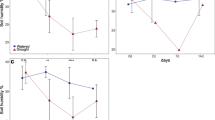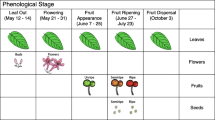Abstract
Floral biochemistry and stress physiology is an underexplored aspect of mangroves, which should be investigated as part of preservation and restoration efforts. A thriving true mangrove tree (Bruguiera gymnorrhiza (L.) Lamk.) and a threatened mangrove-associate species (Heritiera fomes Buch. Ham.) were studied in the Sundarban region of India for seasonal variations in floral odours, non-volatile phytochemicals, antioxidant enzyme activities, and surface water chemistry in surrounding habitat. Both species were found to exhibit significant differences in floral volatilomes, protein contents, antioxidant enzyme activities, total flavonoids, and total phenolic contents between spring and autumn blooms. The bird-pollinated flowers of B. gymnorrhiza also showed considerable seasonal differences in floral anthocyanin and proline contents, indicating vulnerability of the post-anthesis open flowers to environmental factors. Contrarily to previous findings, B. gymnorrhiza floral bouquet appeared to be enriched in various classes of volatiles – dominated by sulphurous compounds in bud stage and terpenoids in open stage. Floral anthocyanins, contributing to the striking colouration of the calyx, were found to comprise cyanidin and delphinidin derivatives. Other glycosides of cyanidin and delphinidin were detected in H. fomes flowers, contributing to visual guides to potential food rewards for pollinating insects. Floral tissue in H. fomes was found to be protected by densely overlapping layers of stellate trichomes containing sesquiterpenoids as phytoprotectants. Comparison of the two floral species suggested that H. fomes flowering is optimized to oligohaline (but not freshwater) vernal conditions; whereas B. gymnorrhiza blooms are adapted for biologically enriched (including abundant herbivores and microbial growth), mesohaline forest habitats.






Similar content being viewed by others
Data availability
Data supporting the findings of this study are available within the paper and its Supplementary Information file. Any raw data files needed in another format will be made available upon request.
References
Ahmadiani N, Robbins RJ, Collins TM, Giusti MM (2016) Molar absorptivity (ε) and spectral characteristics of cyanidin-based anthocyanins from red cabbage. Food Chem 197:900–906. https://doi.org/10.1016/j.foodchem.2015.11.032
Ainsworth EA, Gillespie KM (2007) Estimation of total phenolic content and other oxidation substrates in plant tissues using Folin-Ciocalteu reagent. Nat Protoc 2:875–877. https://doi.org/10.1038/nprot.2007.102
Ancillotti C, Ciofi L, Rossini D, Chiuminatto U, Stahl-Zeng J, Orlandini S, Furlanetto S, Del Bubba M (2016) Liquid chromatographic/electrospray ionization quadrupole/time of flight tandem mass spectrometric study of polyphenolic composition of different Vaccinium berry species and their comparative evaluation. Analyt Bioanalyt Chem 409:1347–1368. https://doi.org/10.1007/s00216-016-0067-y
APHA (2005) Standard Methods for the Examination of Water and Wastewater, twenty-first edition. American Public Health Association/American Water Works Association/Water Environment Federation, Washington
APHA (1998) Standard Methods for the Examination of Water and Wastewater, twentieth edition. American Public Health Association, American Water Works Association and Water Environmental Federation, Washington DC
Azuma H, Toyota M, Asakawa Y, Takaso T, Tobe H (2002) Floral scent chemistry of mangrove plants. J Plant Res 115:47–53. https://doi.org/10.1007/s102650200007
Bhatt V, Sendri N, Swati K, Shinde BD, Bhandari P (2022) Identification and quantification of anthocyanins, flavonoids, and phenolic acids in flowers of Rhododendron arboreum and evaluation of their antioxidant potential. J Separat Sci 2022:1–11. https://doi.org/10.1002/jssc.202200145
Blažytė-Čereškienė L, Apšegaitė V, Būda V (2019) The choice between flowers of closely related plant species by generalist pollinator: identification of relevant VOCs. Arthropod Plant Interact 13:735–743. https://doi.org/10.1007/s11829-019-09702-2
Bradford M (1976) A rapid and sensitive method for the quantification of microgram quantities of proteins utilising the principal of protein-dye binding. Analyt Biochem 72:248–254. https://doi.org/10.1006/abio.1976.9999
Bruce TJA, Wadhams LJ, Woodcock CM (2005) Insect host location: a volatile situation. Trends Plant Sci 10:1360–1385. https://doi.org/10.1016/j.tplants.2005.04.003
Burdon RCF, Junker RR, Scofeld DG, Parachnowitsch AL (2018) Bacteria colonising Penstemon digitalis show volatile and tissue specific responses to a natural concentration range of the floral volatile linalool. Chemoecology 28:11–19. https://doi.org/10.1007/s00049-018-0252-x
Carillo P, Gibon Y (2011) Protocol: extraction and determination of proline. PrometheusWiki
Chung SH, Felton GW (2011) Specificity of induced resistance in tomato against specialist lepidopteran and coleopteran species. J Chem Ecol 37:378–386. https://doi.org/10.1007/s10886-011-9937-0
Corsi G, Bottega S (1999) Glandular hairs of Salvia officinalis: new data on morphology, localization and histochemistry in relation to function. Ann Bot 84:657–664. https://doi.org/10.1006/anbo.1999.0961
Csepregi K, Kocsis M, Hideg É (2013) On the spectrophotometric determination of total phenolic and flavonoid contents. Acta Biol Hung 64:500–509. https://doi.org/10.1556/ABiol.64.2013.4.10
Dela G, Or E, Ovadia R, Nissim-Levi A, Weiss D, Oren-Shamir M (2003) Changes in anthocyanin concentration and composition in ‘Jaguar’ rose flowers due to transient high-temperature conditions. Plant Sci 164:333–340. https://doi.org/10.1016/S0168-9452(02)00417-X
Geissman TA, Griffin TS (1971) Sesquiterpene lactones: acid-catalysed color reactions as an aid in structure determination. Phytochemistry 10:2475–2485. https://doi.org/10.1016/S0031-9422(00)89894-5
Gfrerer E, Laina D, Gibernau M, Fuchs R, Happ M, Tolasch T, Trutschnig W, Hörger AC, Comes HP, Dötterl S (2021) Floral scents of a deceptive plant are hyperdiverse and under population-specific phenotypic selection. Front Plant Sci 12:719092. https://doi.org/10.3389/fpls.2021.719092
Ghosh S, Majumdar S, Roychowdhury T (2019) Assessment of the effect of urban pollution on surface water–groundwater system of Adi Ganga, a historical outlet of river Ganga. Chemosphere 237:124507. https://doi.org/10.1016/j.chemosphere.2019.124507
Gong J-X, Shen X, Yao L-G, Jiang H, Krohn K, Guo Y-W (2007) Total synthesis of gymnorrhizol, an unprecedented 15-membered macrocyclic polydisulfide from the Chinese mangrove Bruguiera gymnorrhiza. Org Lett 9:1715–1716. https://doi.org/10.1021/ol0703783
Han L, Huang XS, Sattler I, Fu H-Z, Grabley S, Lin W-H (2007) Two new constituents from mangrove Bruguiera gymnorrhiza. J Asian Nat Products Res 9:327–331. https://doi.org/10.1080/10286020600727574
Hirata H, Ohnishi T, Watanabe N (2016) Biosynthesis of floral scent 2-phenylethanol in rose flowers. Biosci Biotechnol Biochem 80:1865–1873. https://doi.org/10.1080/09168451.2016.1191333
Jebara S, Jebara M, Limam F, Aouani ME (2005) Changes in ascorbate peroxidase, catalase, guaiacol peroxidase and superoxide dismutase activities in common bean (Phaseolus vulgaris) nodules under salt stress. J Plant Physiol 162:929–936. https://doi.org/10.1016/j.jplph.2004.10.005
Karaaslan NM, Yaman M (2016) Determination of anthocyanins in cherry and cranberry by high-performance liquid chromatography–electrospray ionization–mass spectrometry. Eur Food Res Technol 242:127–135. https://doi.org/10.1007/s00217-015-2524-9
Kathiresan K (2010) Globally threatened mangrove species in India. Curr Sci 98:1551
Kathiresan K, Bingham BL (2001) Biology of mangroves and mangrove ecosystems. Adv Marine Biol 40:81–251. https://doi.org/10.1016/S0065-2881(01)40003-4
Kessler A, Baldwin IT (2006) Making sense of nectar scents: the effects of nectar secondary metabolites on floral visitors of Nicotiana attenuata. Plant J 49:840–854. https://doi.org/10.1111/j.1365-313X.2006.02995.x
Klatt BK, Burmeister C, Westphal C, Tscharntke T, von Fragstein M (2013) Flower volatiles, crop varieties and bee responses. PLoS One 8:e72724. https://doi.org/10.1371/journal.pone.0072724
Kondo K, Nakamura T, Tsuruda K, Saito N, Yaguchi Y (1987) Pollination in Bruguiera gymnorrhiza and Rhizophora mucronata (Rhizophoraceae) in Ishigaki Island, the Ryukyu Islands, Japan. Biotropica 19:377–380. https://doi.org/10.2307/2388639
Kondo K, Nakamura T, Piyakarnchana T, Mechvichai W (1991) Pollination in Bruguiera gymnorrhiza (Rhizophoraceae) in Miyara River, Ishigaki Island, Japan, and Phangnga, Thailand. Plant Spec Biol 6:105–109. https://doi.org/10.1111/j.1442-1984.1991.tb00216.x
Liu J, Zhang J, Shen J, Zhao H, Ma W, Jiang Y (2022) Differences in EAG response and behavioral choices between honey bee and bumble bee to tomato flower volatiles. Insects 13:987. https://doi.org/10.3390/insects13110987
Lopes-Da-Silva F, de Pascual-Teresa S, Rivas-Gonzalo J, Santos-Buelga C (2002) Identification of anthocyanin pigments in strawberry (cv Camarosa) by LC using DAD and ESI-MS detection. Eur Food Res Technol 214:248–253. https://doi.org/10.1007/s00217-001-0434-5
Maity D, Mandal M, Midday M, Ghosh J, Maiti GG (2020) Mangroves of the Sundarbans, India. East Himalayan Society for Sparmatophyte Taxonomy, India. ISBN: 978-81-924956-6-8
Moon UR, Mitra A (2016) A mechanistic insight into hydrogen peroxide-mediated elicitation of bioactive xanthones in Hoppea fastigiata shoot cultures. Planta 244:259–274. https://doi.org/10.1007/s00425-016-2506-6
Paul I, Bhadoria PBS, Mitra A (2020) Seasonal and diel variations in scent composition of ephemeral Murraya paniculata (Lin.) Jack fowers are contributed by separate volatile components. Biochem Syst Ecol 89:104004. https://doi.org/10.1016/j.bse.2020.104004
Paul I, Dutta M, Mitra A (2021) Characterization of osmophore activity and secondary metabolite localization in fragrant ephemeral flowers of Murraya paniculata (Linn.) Jack (Rutaceae). Brazil J Bot 44:941–955. https://doi.org/10.1007/s40415-021-00775-z
Paul I, Bhadoria PBS, Poddar Sarkar M (2022) Floral secondary metabolites in context of biotic and abiotic stress factors. Chemoecology 32:49–68. https://doi.org/10.1007/s00049-021-00366-0
Pellmyr O (2002) Pollination by animals. In: Herrera CM, Pellmyr O (eds) Plant-animal interactions. Blackwell Science Ltd, UK, pp 157–184. ISBN: 0–632–05267–8
Peñuelas J, Farré-Armengol G, Llusia J, Gargallo-Garriga A, Rico L, Sardans J, Terradas J, Filella I (2014) Removal of floral microbiota reduces floral terpene emissions. Sci Rep 4:6727. https://doi.org/10.1038/srep06727
Pluskal T, Castillo S, Villar-Briones A, Orešič M (2010) MZmine 2: Modular framework for processing, visualizing, and analyzing mass spectrometry-based molecular profile data. BMC Bioinform 11:395
Rodrigues Marques P, Amorim L, Silva-Junior GJ, Spósito MB, Appezzato-da Gloria B (2015) Structural and biochemical characteristics of citrus flowers associated with defence against a fungal pathogen. AoB PLANTS. https://doi.org/10.1093/aobpla/plu090
Rubinskiene M, Jasutiene I, Venskutonis PR, Viskelis P (2005) HPLC determination of the composition and stability of blackcurrant anthocyanins. J Chromatographic Sci 43:478–482. https://doi.org/10.1093/chromsci/43.9.478
Santos DT, Cavalcanti RN, Rostagno MA, Queiroga CL, Eberlin MN, Meireles MAA (2013) Extraction of polyphenols and anthocyanins from the Jambul (Syzygium cumini) fruit peels. Food Public Health 3:12–20. https://doi.org/10.5923/j.fph.20130301.02
Tomlinson PB, Primack RB, Bunt JS (1979) Preliminary observations on floral biology in mangrove Rhizophoraceae. Biotropica 11:256–277. https://doi.org/10.2307/2387918
Wangensteen H, Dang HCT, Jamal Uddin S, Alamgir M, Malterud KE (2009) Antioxidant and antimicrobial effects of the mangrove tree Heritiera fomes. Nat Product Commun 4:371–376. https://doi.org/10.1177/1934578X0900400311
Wu Q, Wang M, Simon JE (2003) Determination of proanthocyanidins in grape products by liquid chromatography/mass spectrometric detection under low collision energy. Analyt Chem 75:2440–2444. https://doi.org/10.1021/ac0262311
Wu L-c, Hsu H-W, Chen Y-C, Chiu C-C, Lin Y-I, Ho J-AA (2006) Antioxidant and antiproliferative activities of red pitaya. Food Chem 95:319–327. https://doi.org/10.1016/j.foodchem.2005.01.002
Wu J, Xiao Q, Xu J, Li M-Y, Pan J-Y, Yang M-h (2008) Natural products from true mangrove flora: source, chemistry, and bioactivities. Nat Product Rep 25:955–981. https://doi.org/10.1039/b807365a
Acknowledgements
This work was supported by the Science and Engineering Research Board (SERB) of the Department of Science and Technology (DST), New Delhi, India, with a SERB-National Post Doctoral Fellowship (PDF/2020/000803) allocated to Dr. Ishita Paul. Facilities for microscopy (Dewinter, Stereomaster-Plus and Dewinter, Excel) and UV-VIS spectrophotometer (Shimadzu UV-2600) were provided by the Department of Life Sciences, Presidency University, Kolkata, courtesy of a DST-FIST programme, Government of India (No.SR/FST/LSI560/2013 (c) dated 29.05.2020). Facilities for GC-MS were kindly provided by DBT-BUILDER programme, Government of India (BT/INF/22/SP45088/2022 dated 17.02.2022) at the Department of Life Sciences, Presidency University, Kolkata, and by the Department of Instrumentation and Electronics Engineering, Jadavpur University, Kolkata, courtesy of Dr. Prolay Sharma and Dr. Nilava Debabhuti. We wish to thank the Joygopalpur Gram Bikash Kendra, West Bengal, India, for allowing access to private landholdings for sampling purposes.
Author information
Authors and Affiliations
Corresponding author
Ethics declarations
Conflict of interests
On behalf of all authors, the corresponding author states that there is no conflict of interest.
Additional information
Publisher's Note
Springer Nature remains neutral with regard to jurisdictional claims in published maps and institutional affiliations.
Supplementary Information
Below is the link to the electronic supplementary material.
Rights and permissions
Springer Nature or its licensor (e.g. a society or other partner) holds exclusive rights to this article under a publishing agreement with the author(s) or other rightsholder(s); author self-archiving of the accepted manuscript version of this article is solely governed by the terms of such publishing agreement and applicable law.
About this article
Cite this article
Paul, I., Manna, S., Bera, R. et al. Floral scents, specialized metabolites and stress-response activities in Heritiera fomes and Bruguiera gymnorrhiza from Sundarban mangrove ecosystem. J Plant Res 137, 463–484 (2024). https://doi.org/10.1007/s10265-024-01527-2
Received:
Accepted:
Published:
Issue Date:
DOI: https://doi.org/10.1007/s10265-024-01527-2




